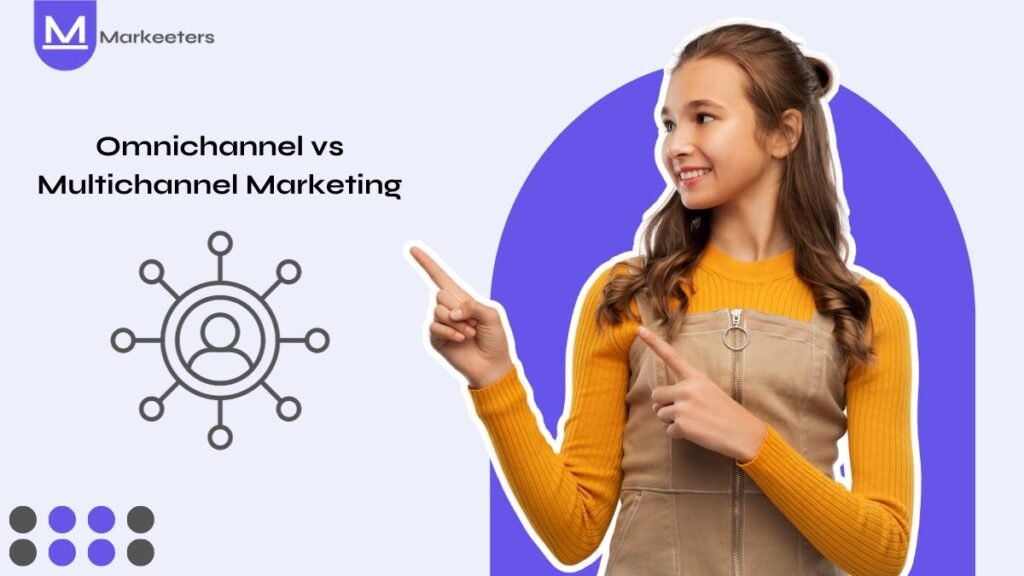The terms “omnichannel” and “multichannel” are often used in business and marketing. Let’s explore our interesting blog: Omnichannel vs. Multichannel Marketing: What’s the Difference to learn more.
Just imagine: You are browsing your favorite shopping store on your laptop. You add items to the cart but don’t buy anything. Later in the day, you receive a personalized email on your phone reminding you of the items left in the shopping cart. For example, “Hey! You did not checkout!” or “Hi XYZ! The prices of the items in your cart are slashed. Buy them now!” While walking past the store, you get a mobile notification offering a discount on those items. What is happening? Does this make you curious?
This is the world of modern marketing. Businesses are experimenting with omnichannel and multichannel marketing to develop streamlined, memorable customer experiences. In this blog, we will study:
- The definition of Omnichannel Marketing+ example
- The definition of Multichannel Marketing+ example
- The difference between omnichannel and multichannel
Let’s dive in!
What is Omnichannel Marketing?
Omnichannel refers to a customer-centric approach integrating all channels and delivering a unified and consistent brand experience across physical stores, applications, and websites. This ensures that the brand can be easily integrated into various platforms, which in turn increases the customer’s overall experience of the brand. In simple terms, omnichannel refers to leveraging several channels to connect with customers. Omnichannel assures quality regardless of when or how customers connect with your business.
With omnichannel marketing, you can simultaneously build campaigns, promotions, and messages that are consistent across all platforms. The effort should be uniform and smooth regardless of whether the customer is buying online from a desktop or mobile device, over the phone, or in a physical store. When done correctly, omnichannel marketing makes sure that customers receive offers that are pertinent to their needs and their interactions with your business.
Example
IKEA
IKEA, the renowned home furnishing business, is an exciting example of omnichannel marketing. In order to give you a unique brand experience, the business brings together both retail and online experiences. The mobile app features allow IKEA customers to store digital catalogs in their shopping lists at stores. In addition to this, the business has opened pick-up and delivery points. This is done to bring deliveries closer to customers’ homes and enhance their brand experience.
IKEA is also known for its innovative omnichannel strategy performance measurement. In order to evaluate its offline strategy, the company has made use of Google AdWords Store Visits.

How does Omnichannel Marketing Work?
Here are a few examples of omnichannel marketing to help you understand the concept:
- While in-store, a customer receives a text message regarding a deal.
- Instagram retargets a customer with the item they left in their virtual shopping cart.
- A promotional email informs recipients to keep an eye out for a real postcard coupons for discounts.
These examples showcase how omnichannel marketing mean combining many channels that cooperate to give your customers an enjoyable and consistent experience. Additionally, you can also check an overview of your consumer interactions across many touchpoints by utilizing an omnichannel marketing strategy.
What is Multichannel Marketing?
Multichannel marketing involves the use of many media channels to reach out to current and prospective customers. TV, print, social media, email, billboards, display ads, and more can be seen on the channels. These channels are not always interconnected with one another. For instance, your Facebook ad can have entirely different content and design than your promotional emails. Each channel operates independently. So, customers must access that particular channel in order to find the information they are looking for.
A multichannel approach engages customers across a variety of independent touchpoints, including websites, social media, mobile applications, and physical storefronts. The main objective is to increase the business’s market share and make sure that its products and services are accessible on many platforms in order to cater to a wide range of consumer demands.
Example
Apple
When Apple realized that most of its sales were made online, it adopted an innovative approach with its retail stores. Instead of focusing on increasing sales and revenue, the retail spaces offer improved customer experiences. It helps Apple users to connect with the brand. Customers visit stores more frequently because they experience less pressure to buy.
With their sleek, aesthetic, and simple look, it is easily identifiable. This provides for excellent advertising. They are often built with modern designs that stand out in any surroundings.

How does Multichannel Marketing Works?
Creating a marketing plan based on thorough research is the first step in the entire process. By utilizing a variety of media, the objective is to increase conversions and broaden the brand’s audience. There is a little attempt made to combine the marketing strategies and channels when marketers create channel-specific marketing plans.
Typically, creating a multichannel marketing plan involves the following steps:
- Understand the target audience and developing a buyer persona
- Choosing appropriate channels to communicate your target audience like email marketing, social media, mobile marketing, direct mail, PPC ads, retail showrooms, content marketing
- Creating customized advertising content for every medium
- Monitoring every channel’s performance independently
- Modifying the approach for every channel
Also read: Growth Team Vs. Marketing Team (& How They Can Work Together)
Omnichannel vs. Multichannel Marketing: What’s the Difference
There are a few main differences between omnichannel and multichannel marketing:
| Criteria | Omnichannel | Multichannel |
|---|---|---|
| Consistency | Easy customer journey with seamless transitions between online and offline channels, enabling a cohesive experience. | Customer experience varies between channels. This leads to inconsistencies in branding and messaging. |
| Integration | Channels are interconnected and integrated, providing a unified and seamless customer experience across all platforms. | Channels operate independently, functioning as separate entities without significant integration. |
| Data Accessibility | Centralized data accessibility, allowing businesses to track customer interactions and preferences across all channels. | Data may be segregated in individual channels, making it challenging to gain a holistic view of customer behavior and preferences. |
| Personalization | Enhanced personalization opportunities as data from various channels are consolidated, enabling tailored communication. | Limited personalization, as customer data is often restricted to specific channels, hindering comprehensive customization. |
| Customer Journey | Fragmented customer’s journey with limited integration, leading to potential breaks in the overall experience. | Limited personalization, as customer data is often restricted to specific channels, hinders comprehensive customization. |
| Operational Complexity | Requires robust integration systems and technological infrastructure to ensure seamless communication between channels. | Relatively simpler operational setup as each channel functions independently without extensive integration needs. |
| Customer Loyalty | Higher potential for building customer loyalty due to consistent and tailored experiences, fostering stronger brand-customer relationships. | Customer loyalty may be fragmented, with varying experiences leading to less consistent brand attachment. |
Learn more: Inbound vs Outbound Marketing: What’s the Difference?
How to Pick the Best Approach for Your Business?
The omnichannel approach provides a better customer experience that seems effective. However, everything is not perfect. You can decide which strategy to use depending on whether you want to launch your company as a physical store or a digitally native brand. It looks like omnichannel is the ideal choice; however, some businesses would be better off starting off with a multichannel marketing approach.
Consider two things:
Flexibility:
People and incentives play a significant role in the shift to omnichannel. In spite of the impact these objectives have on adjacent channels or the customer experience at large, resist incentives that reward maximizing sales in each channel.
Resources:
The right IT investment and technical expertise, the correct infrastructure and tech stack, as well as a clear vision to integrate and implement, are all necessary for delivering an omnichannel experience. If you don’t have IT staff in-house, it may be necessary to hire technology experts for the online store.
In order for the vision to be adopted across the company, it is especially important that both CMOs and CIOs develop a vision. Make sure your executive management team is equipped with the necessary technical competence to implement parts of the omnichannel transformation. It begins by clearly defining the difference between omnichannel and multichannel marketing in order to understand which approach is best for your brand.
Conclusion
With this, we conclude the significant differences between omnichannel and multichannel marketing. Business leaders would be more likely to include omnichannel marketing in their marketing plans, given that it provides a seamless customer experience. However, they must be competent to handle the related challenges. The primary hurdles in the way of omnichannel are the associated expense and complexity. At the same time, omnichannel marketing automation offers a compelling chance to prepare for the future.
Multichannel marketing may appear to be a desirable choice, but given how rapidly consumer expectations and behavior are changing how businesses conduct themselves it may only be a temporary answer. Businesses will eventually be required to use omnichannel marketing.
More resources only for you:
How to Prioritize Marketing Channels Based on ROI
Is Pinterest a Social Media or a Search Engine?
Twitter Alternatives | 10 Best Apps Similar To X (Twitter)
Top 10 Best Social Media Platforms for Freelancers 2023
Frequently Asked Questions
Is Amazon omnichannel or multichannel?
Amazon is an omnichannel retailer because it offers customers a smooth, unified shopping experience between all its different modes of delivery, e.g. in in-store, on the Internet, and through smartphones.
What is omnichannel for example?
Omnichannel is a technique to engage with customers across all platforms. This could mean your website, social media, direct mail, or phone calls. Whatever method is used, remember that it results in better interactions with customers, retention rates, and exposure to the brand.
What is an example of multichannel marketing?
Multichannel refers to the use of multiple media channels for the dissemination of marketing messages. It may include but is not limited to, email, Facebook, newspapers, cell phones, display advertising, TV, and more. As part of a more holistic campaign, the use of several channels allows brands to reach their customers at different points in time.





